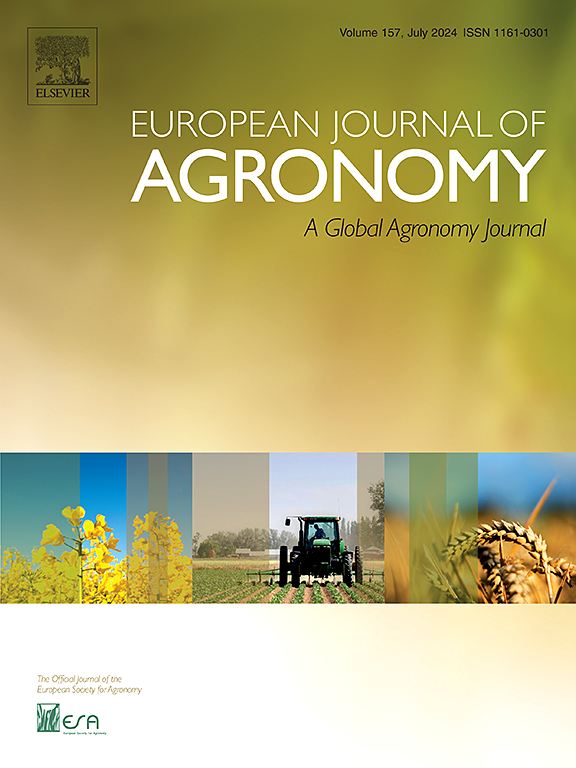Balancing yield, water productivity, and fruit quality of processing tomatoes through the combined use of biodegradable mulch film and regulated deficit irrigation
IF 4.5
1区 农林科学
Q1 AGRONOMY
引用次数: 0
Abstract
Italy is the third largest producer of processing tomatoes (Solanum lycopersicum L.) worldwide. Tomato production is projected to be considerably affected by climate change, especially in drought-prone regions where maximizing water use efficiency is essential. A two-year on-farm experiment was conducted to compare full irrigation (T1) with two water-saving irrigation strategies: T2 (regulated deficit irrigation, RDI) and T3 (RDI combined with soil-biodegradable mulch film). The experiment was conducted at two representative sites in southern Italy, where yield performance, sustainability, and fruit quality were assessed. T2 resulted in 31 % water savings and maintained comparable yields, increasing irrigation (+44 %) and economic (+56 %) water productivities with respect to T1. Nevertheless, the accelerated crop cycle observed in T2 reduced the leaf coverage of fruit, leading to a higher number of sun-scalded fruits and decreased lycopene content at harvest. The negative effects of RDI were partially mitigated by combining it with soil-biodegradable mulch film (T3), which improved the soluble solid content (+4 %), marketable (+23 %) and Brix (+28 %) yields, and irrigation (+71 %) and economic (+78 %) water productivities compared with T1. Metabolic profiling further highlighted that T3 increased key stress-related metabolites, including alanine (+50 %), glycine (+31 %), and proline (+44 %), indicating enhanced metabolic adaptation to water stress. The increase in proline, a crucial osmolyte and antioxidant, suggests improved nitrogen use efficiency and overall metabolic resilience under water-deficient conditions. Based on these findings, T3 is recommended as a valuable practice for improving yield and sustainability, while maintaining fruit quality in drought-prone areas.
生物可降解地膜和调节亏缺灌溉对加工番茄产量、水分生产力和果实品质的平衡
意大利是世界上第三大加工番茄(茄)生产国。预计番茄产量将受到气候变化的严重影响,特别是在水资源利用效率最大化至关重要的干旱易发地区。通过为期两年的田间试验,比较了完全灌溉(T1)与2种节水灌溉策略:T2(调节亏缺灌溉,RDI)和T3 (RDI与土壤-生物可降解地膜结合)。该试验在意大利南部两个具有代表性的地点进行,对产量表现、可持续性和水果质量进行了评估。与T1相比,T2节水31 %,保持了相当的产量,提高了灌溉(+44 %)和经济(+56 %)水分生产力。然而,T2作物周期的加快降低了果实的叶片覆盖度,导致果实被晒伤的数量增加,收获时番茄红素含量降低。与土壤-生物可降解地膜(T3)配合使用,可部分缓解RDI的负面影响,与T1相比,可溶固形物含量(+4 %)、可售(+23 %)和白利度(+28 %)产量以及灌溉(+71 %)和经济(+78 %)水分生产力均有所提高。代谢分析进一步强调,T3增加了关键的应激相关代谢物,包括丙氨酸(+50 %)、甘氨酸(+31 %)和脯氨酸(+44 %),表明增强了对水分胁迫的代谢适应。脯氨酸是一种重要的渗透物和抗氧化剂,脯氨酸的增加表明在缺水条件下氮的利用效率和整体代谢恢复能力提高。基于这些研究结果,建议在干旱易发地区采用T3作为提高产量和可持续性,同时保持果实品质的有价值的做法。
本文章由计算机程序翻译,如有差异,请以英文原文为准。
求助全文
约1分钟内获得全文
求助全文
来源期刊

European Journal of Agronomy
农林科学-农艺学
CiteScore
8.30
自引率
7.70%
发文量
187
审稿时长
4.5 months
期刊介绍:
The European Journal of Agronomy, the official journal of the European Society for Agronomy, publishes original research papers reporting experimental and theoretical contributions to field-based agronomy and crop science. The journal will consider research at the field level for agricultural, horticultural and tree crops, that uses comprehensive and explanatory approaches. The EJA covers the following topics:
crop physiology
crop production and management including irrigation, fertilization and soil management
agroclimatology and modelling
plant-soil relationships
crop quality and post-harvest physiology
farming and cropping systems
agroecosystems and the environment
crop-weed interactions and management
organic farming
horticultural crops
papers from the European Society for Agronomy bi-annual meetings
In determining the suitability of submitted articles for publication, particular scrutiny is placed on the degree of novelty and significance of the research and the extent to which it adds to existing knowledge in agronomy.
 求助内容:
求助内容: 应助结果提醒方式:
应助结果提醒方式:


